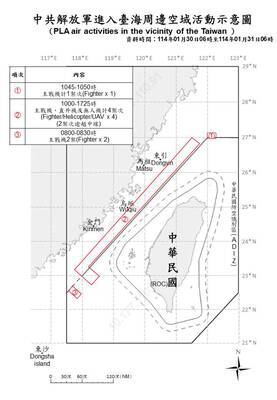The interval between big earthquakes in Taiwan could be about a decade, if 10 recently discovered active faults in the south are taken into account, geologists at National Taiwan University (NTU) said yesterday.
After more than 2,400 lives were claimed by a 7.3 magnitude temblor in Taiwan on Sept. 21, 1999, Taiwanese geologists and seismologists began to review all active faults in a bid to find signs of when the next big earthquake might be.
By digging trenches along the Chelungpu Fault (車籠埔斷層), site of the disastrous 921 earthquake, Chen Wen-shan (陳文山), a NTU geosciences professor, has spent almost four years trying to discover the average period between the fault's dramatic movements.
"According to our studies, we conclude that the interval between the Chelungpu Fault's dramatic movements is between 350 and 400 years," Chen said yesterday at a press conference.
In other words, Chen said, Chelungpu could be regarded as one of the less threatening faults in Taiwan now, because accumulated energy has been released.
But Chen and his team discovered 10 faults in the plain between Chiayi and Kaohsiung.
Together with 42 active faults announced by the Central Geological Survey under the Ministry of Economic Affairs, Chen said, more than 50 active faults across Taiwan island might cause a devastating earthquake about every 10 years.
"Experiencing big earthquakes is the common destiny of people living in Taiwan, one of the most dangerous earthquake-prone areas in the world," Chen said.
Chen said the government should strongly support the survey on the activities of faults near urban areas and science parks and set up geology-related laws to regulate land use in areas near active faults.
Chen said that, at 1,600 people per square kilometer, Taiwan ranks eighth in the world in terms of population density.
"If we can't avoid using land near active faults, great casualties caused by earthquakes can be expected," Chen said.
Seventeen scientists are involved with the NT$30 million research, which is provided by the National Science Council and the Ministry of Economic Affairs.
Geologists yesterday reminded residents that the frequency of large earthquakes was unpredictable. Taiwan experienced earthquakes measuring more than 7 on the Richter scale in 1935, 1941, 1946 and 1951.
NTU scientists said people should be alert to the threats posed by earthquakes and strengthen the earthquake resistance of buildings.
"Western Taipei could be disastrously struck by a big earthquake if a nearby fault moves," said Chen Yue-gau (
However, not everyone agreed with the scientists' conclusions.
Deputy Director General of the Central Weather Bureau Shin Tzay-chyn (
He said people should be aware of the dangers earthquakes pose because, "after all, we can't avoid living in earthquake-prone areas."
The NTU scientists said that they would focus on faults in eastern Taiwan. The economics ministry's Central Geological Survey designated 25 faults that potential threaten to produce earthquakes.

Taiwanese actress Barbie Hsu (徐熙媛) has died of pneumonia at the age of 48 while on a trip to Japan, where she contracted influenza during the Lunar New Year holiday, her sister confirmed today through an agent. "Our whole family came to Japan for a trip, and my dearest and most kindhearted sister Barbie Hsu died of influenza-induced pneumonia and unfortunately left us," Hsu's sister and talk show hostess Dee Hsu (徐熙娣) said. "I was grateful to be her sister in this life and that we got to care for and spend time with each other. I will always be grateful to

UNITED: The premier said Trump’s tariff comments provided a great opportunity for the private and public sectors to come together to maintain the nation’s chip advantage The government is considering ways to assist the nation’s semiconductor industry or hosting collaborative projects with the private sector after US President Donald Trump threatened to impose a 100 percent tariff on chips exported to the US, Premier Cho Jung-tai (卓榮泰) said yesterday. Trump on Monday told Republican members of the US Congress about plans to impose sweeping tariffs on semiconductors, steel, aluminum, copper and pharmaceuticals “in the very near future.” “It’s time for the United States to return to the system that made us richer and more powerful than ever before,” Trump said at the Republican Issues Conference in Miami, Florida. “They

TAIWAN DEFENSE: The initiative would involve integrating various systems in a fast-paced manner through the use of common software to obstruct a Chinese invasion The first tranche of the US Navy’s “Replicator” initiative aimed at obstructing a Chinese invasion of Taiwan would be ready by August, a US Naval Institute (USNI) News report on Tuesday said. The initiative is part of a larger defense strategy for Taiwan, and would involve launching thousands of uncrewed submarines, surface vessels and aerial vehicles around Taiwan to buy the nation and its partners time to assemble a response. The plan was first made public by the Washington Post in June last year, when it cited comments by US Indo-Pacific Commander Admiral Samuel Paparo on the sidelines of the Shangri-La Dialogue

REMINDER: Of the 6.78 million doses of flu vaccine Taiwan purchased for this flu season, about 200,000 are still available, an official said, following Big S’ death As news broke of the death of Taiwanese actress and singer Barbie Hsu (徐熙媛), also known as Big S (大S), from severe flu complications, the Centers for Disease Control (CDC) and doctors yesterday urged people at high risk to get vaccinated and be alert to signs of severe illness. Hsu’s family yesterday confirmed that the actress died on a family holiday in Japan due to pneumonia during the Lunar New Year holiday. CDC Deputy Director-General Tseng Shu-hui (曾淑慧) told an impromptu news conference that hospital visits for flu-like illnesses from Jan. 19 to Jan. 25 reached 162,352 — the highest